 |
|||||||||||||||||||||
| In the class emphasizing focus and resolution, the Wilson/ VTL /Transparent demo in the 2nd floor ball room epitomized the genre. Of course, using personal master tapes as Wilson's Peter McGrath was able to do is the wet dream of any exhibitor. Still, if you've got it, flaunt it, sesame (sez a me). And flaunt it they did: Give it up for Luke Manley of VTL and his under-handedly elegant partner in crime. |
|||||||||||||||||||||
 |
|||||||||||||||||||||
| The Wilson MAXX speakers were tethered to VTL's new 800-watt, $40K/pr Siegfried Reference monos, themselves hitched to the firm's fully balanced, twin 12AX7/Mosfet two-box TL7.5 Reference Line Preamplifier. | |||||||||||||||||||||
 |
|||||||||||||||||||||
 |
|||||||||||||||||||||
Siegfried's transformer taps are optimized for 5 ohms to deliver the full-stated power into 4 ohms and remain stable into 2. The tube complement consists of a 12AT7 input tube, 6350 driver (a high-power derivative of the 12BH7) and twelve paralleled 6550Cs. Dubbed a "smart" amplifier, in-house developed logic software controls all operating parameters such as tubes drawing too little current (the circuit compensates but a green light alerts the user which tube is sagging); tubes drawing too much (auto shutdown); bias monitoring and constant adjustments throughout the tubes' life cycle; under/over-voltage incidents; brown-outs and thermal runaway. An RS232 communications port can interface with a Crestron system. By CES, a 300-watt "Son of Siegfried" stereo amp in the same tower chassis should premiere (ca. $20,000). Ditto for a single-box version of the TL7.5 preamp dubbed the 6.5 (estimated price range $6-8K). |
|||||||||||||||||||||
| The remainder of this system? A Theta Carmen transport, EMM Labs Meitner DAC, a VPI HRX turntable with Lyra Helicon and a 24-bit Tascam tape deck. Demoing two renditions of "Fever", one digital, one vinyl, one by Elvis, one by a female vocalist probably world-famous and instantly recognizable to one and all 'cept me (Jazz isn't my forte), Peter McGrath gently poked fun at the raging debate over which format is superior. Indeed, both sounded swell. His coup-de-grace? A modern Duke Ellington Big Band tribute he'd mastered himself. It featured the kind of rip-roaring, full-throttle trumpet solos most exhibitors fear will loosen dental fillings and unleash merciless rounds of Strident submarine volleys. Not here. Neither rolled-off and prettified nor brutally in-yer-face, the treble-magic DAC, the powerful tube amps and ultra-precise speakers collaborated to deliver a thrilling performance that emphasized resolution and precision -- hence a modicum of dryness -- over the diaphanous airiness of our previous examples on the last page. A second large-scale exhibit of similar flavor but more "spaciousness" was to be found in the Butler Audio/Cabasse room. |
|||||||||||||||||||||
 |
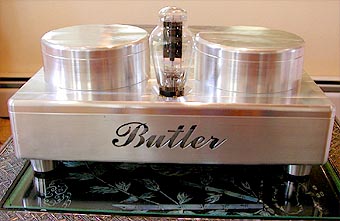 |
||||||||||||||||||||
 |
|||||||||||||||||||||
 |
|||||||||||||||||||||
| The 4-way Cabasse Kara ($14,228/pr) from their top-line Artis range is a superlative technology demonstrator of very serious engineering. It sports the famed tri-concentric TC 22 driver in the top-mounted "cyclops" ball to act as minimum-diffraction point source above 100Hz. The same 30M22 bass driver as used in the stand-alone Cabasse Thor II subwoofer assumes bass duty. | |||||||||||||||||||||
It is mounted below the ball and venting through a cloth-covered circular port in front of it, essentially extending the point-source principle to 30Hz. This 12.3" woofer is used in single rather than twin configuration as in the Thor but never mind that. In this sizeable space, the presenter had to convince attendees that no separate subwoofer was active during 2-channel material. Coulda fooled me! Like their landsmen from Triangle, the Cabasse menschen are sensitive types. They believe in 93.5dB efficiency for this model though the nominal 8-ohm load sports a challenging 3.2-ohm dip. Consequently, the sighting of 300B monoblocks made my eye brows arch steeper than Jack Nicholson's. But wait - where was the honking output transformer - or the predrivers or rectifier tubes for that matter? Quoting from BK Butler's website description of his zero NFB Model 5150 multi-channel hybrid amp, I learned that "previous hybrid designs employing vacuum tubes generally utilized tubes only in impedance-isolated preamp or pre-driver stages. However, we place the triodes exactly where they should be: DC coupled through the advanced multi-emitter, audiophile-quality Sanken bipolar power output devices to the speakers. Therefore, the tubes are positioned to naturally and actively respond to the dynamic speaker load. This also completely eliminates one of the most inefficient and non-musical components in a typical tube power amplifier: the output transformer. |
|||||||||||||||||||||
 |
|||||||||||||||||||||
Without the phase-shift and induction-generation caused by hundreds of turns of wire and massive core iron to overcome, Butler's newly patented current-multiplying DC coupled circuitry allows the 6SL7GT output driver tubes to directly operate into the constant ratio-reduced speaker load". |
|||||||||||||||||||||
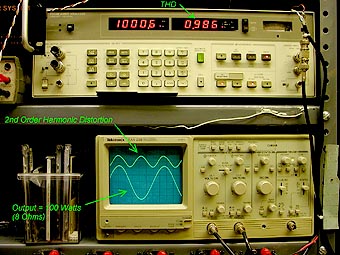 |
Did a 300B trade places with the 6SL7 in this instance? Marketing guy Luis del Castillo was short on hand-out documentation so I fired off a post-show e-mail to the designer to learn more about these tantalizing monoblocks that drove these full-range speakers without breaking a sweat. Here's what I learned: The $ 9,995/pr Model 100-A monoblocks use a genuine Western Electric 300B triode DC-coupled via proprietary current-multiplier circuitry for a conservatively rated, Class A single-ended, zero NFB output 100/200-watt output into 8/4 ohms. Lower impedance power delivery available by special order. Power supply capacitance? Two. That's 2 Farads as in 2,000,000uF. Whoa baby. There's no output transformer. The chassis is CNC machined billet aluminum, the i/o ports are top-line Cardas, and internal parts are from the usual suspects - Vishay, Dale, etc. A true balanced Neutrik input is standard. | ||||||||||||||||||||
Size? 17" deep by 11" wide by 7" high. Weight? 36 lbs. BK Butler was quick to add that the Model 100-A does not employ conventional hybrid architecture. Instead, the base circuitry is already US patented and affords "classic single-ended sound independent of load impedance and power requirements". This includes the $3,295 Model 2250 (2 x 250 watts); the $2,495 Model 3150 ( 3 x 150 watts) and the $3,295 Model 5150 (repeat after me: 5 times 150 watts - gotta love it when the nomenclature is self-explanatory). BK and Luis are working on a comprehensive White Paper detailing the exact operation of the Model 100-A for the AES convention. Check their website for forthcoming tech details. Regardless, I already smell not a rat but rare rose and will keep my eyes peeled on this product. The above test bench shot is compliments of the designer. The sound in this exhibit was spacious yet focused, controlled yet communicative, thus somewhat falling between the "Silk" and "Focus" classes - if one wanted to be persnickety and bureaucratic about this categorizing business. Never mind the fancy lingo, this was another outstanding room. Kudos to all participants. Which brings me to our last entry which, wouldn't you know it, belongs into a class of its own. Frankly, I ran out of boxes to stick it in and had to make up a new one. Ready? |
|||||||||||||||||||||
 |
 |
||||||||||||||||||||
| The joint exhibit of Terry Cain of Cain & Cain and Joe Fratus of Art Audio combining the $1,500 Abby [left in tasty green stain] and the new $3,995, 16-watt Carissa 845 SET [more in the Art Audio coverage]. Single-driver + low-power triodes. Hold on to your toupees. This wasn't your grandma's tea party. | |||||||||||||||||||||
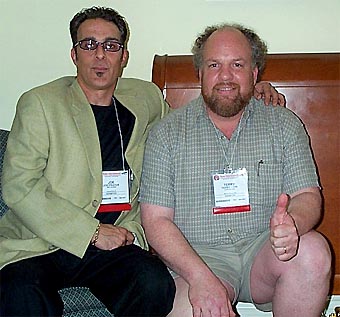 |
|||||||||||||||||||||
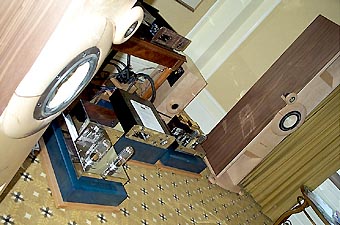 |
|||||||||||||||||||||
| JA was overheard muttering that SETs do do bass after all while Sam Tellig snatched a review pair of Abbys for Stereophile. Depending on time of day and mood of the hosts [dapper Joe Fratus to left, rural master woodworker Terry Cain to right], amplification switched between 6-watt Art Audio PX-25 monos and the new Carissa; and Abbys and BEN-ES ($12,500/pr) with horn-loaded super-tweeter for speakers. Wally Malewicz of WAM Engineering and Wallytractor fame [lower left next to Michael Fremer during Stereophile's 2002 Joint Accessories of the Year Award] walked the halls volunteering on-site measurement services. I wonder how many room let him? Terry did. Wally whipped out his Neutrik/NTI ML1 analyzer with mini SPL mic, MR-1 generator and Ayre test CD. He measured 42 Hz to 16kHz +/-3dB in-room response sans a single room treatment or equalizer in sight, confirmed by a quick post-show phone call. Superb real-world performance if you ask me. No wonder this rig sounded so linear. Terry's forthcoming Super Abby will add a super-tweeter and, with the new 150-watt active 10" aluminum SEAS subwoofer, retail for below $3,500. Greedy me already stuck in a vote for a 4th-quarter review rig. The Abby at SF was the standard version. It uses the Fostex FE166E. It's recommended for rooms of >12'x12'. For smaller spaces, a special near-field version substitutes the FF165K Fostex which actually delivers an additional 10Hz of bass extension. This system had spunk, energy, excitement and a very robust, involving mien. It also excelled at the immediacy and directness that zero NFB triode circuits done right promote, especially when mated to no-crossover full-range drivers. Disc spinner was the excellent Orpheus Laboratories Model Zero, with DAC and preamp duties handled by Gill Audio Design (more on Gill in a subsequent listing). | |||||||||||||||||||||
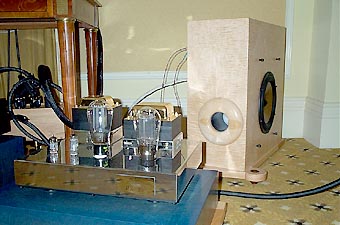 |
|||||||||||||||||||||
 |
|||||||||||||||||||||
A quick anecdote on the Zero. When I chanced upon this exhibit late on Thursday's press-only sneak peek, Terry and Joe were spinning vinyl exclusively. Their promised 47Lab PiTracer had arrived shipping-damaged, due to the loaning dealer packing it poorly. Having just come up from the 2nd floor Joseph Audio/Manley Labs exhibit, I remembered what seemed like a spare transport on passive display. Ambling down the stairs, Jeff Joseph pointed me at the Orpheus Labs Managing Director Marc Chablaix who immediately volunteered to dispatch said unit to total strangers on the 4th floor. It's such white-knight-in-shining-armor stories that make up the secret backbone of events like these. This spine remains invisible to attendees but is indicative of the spirit that unites the professional members of this small specialist community. Danke Schön, Herr Chablaix! This concludes our special-attention exhibits. Regular alphabetical show coverage on following pages. |
|||||||||||||||||||||
 |
 |
||||||||||||||||||||
 |
|||||||||||||||||||||